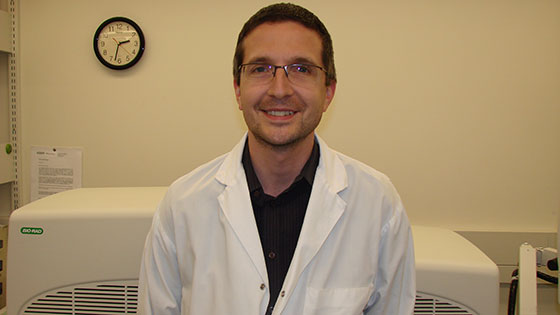This is the second installment of a three-part series highlighting the Laboratory Medicine Program's
critical role in providing quality patient care.

Dr. Ivan Blasutig is helping UHN improve its approach to ANA screening. (Photo: UHN)
"As is your pathology, so goes your clinical care." Dr. William Osler, 1890
Performing millions of tests every year, the Laboratory Medicine Program (LMP) at UHN provides useful, actionable diagnoses for physicians and patients. Laboratory medicine results allow patients to move forward with their care, and the LMP team ensures this information is not only accurate, but cost effective.
As part of our test utilization series, the next example of LMP's strategy looks at how we perform antinuclear antibody (ANA) tests that screen for autoimmune disorders.
Screening for autoimmune disorders
The ANA test is done when a patient shows signs and symptoms associated with systemic lupus erythematosus or other autoimmune disorders; the signs and symptoms include fever, fatigue and joint pain.
In our core laboratory, screening for ANA is usually performed using a system that screens for 11 different autoantibodies at once. In the past, rheumatologists would see results for all 11 autoantibodies on the screen, even if not all results were relevant to their patient.
With a full panel costing over $50, the LMP biochemistry team knew there had to be a better way to get rheumatologists and patients the information they needed and at a much lower cost.
LMP and Rheumatology join forces
"Everything we do in the laboratory comes from a sense of collaboration, so we wanted to work with our rheumatology colleagues to deliver the information that they need, without costing the system too much money," said Dr. Ivan Blasutig, biochemist.
"Our rheumatology patients benefit from our positive relationship with the Laboratory Medicine Program," said Dr. Jorge Sanchez-Guerrero, Chief, Rheumatology. "Dr. Blasutig and I worked together on how the ordering of these tests would be more efficient in terms of cost/benefit without affecting the well-being of patients. Together, we found the way."
"When we looked at how to change the test, we knew we had to be strategic; we didn't want to make a change that would be beneficial for some patients, but require others to undergo further testing," said Dr. Blasutig, who estimates the overall changes to ANA screens will save about $25,000 per year.
"As laboratory medicine professionals, we knew it was our duty to think beyond how to save money on a single test," said Dr. Asa, Medical Director, Laboratory Medicine Program. "Our goal is always to get the patient what they need to move forward in treatment. Our collaboration with the rheumatology team ensured that our change was efficient, would save the system money and was grounded in quality patient care."
Read the first installment in the series:
Vitamin D testing – Cutting costs, not patient care
